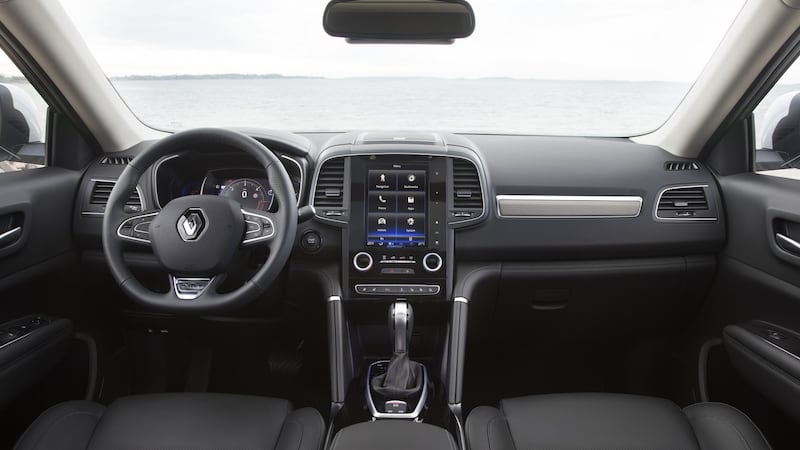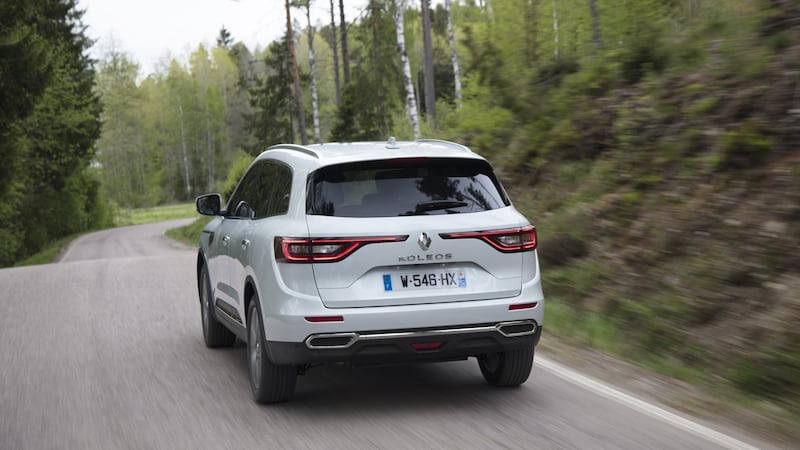I almost did it. I came this close. Driving through the town of Ballinasloe (I lived down west at the time), I came to the conclusion that the 2008 Renault Koleos was one of the worst cars I had ever driven, and I almost parked it up at the side of the road and caught a bus the rest of the way. Had I been more than an hour from home, I might well have followed through on that idle threat, because the Korean-based Koleos (it was essentially a re-badged Korean-made Renault-Samsung Motors SM5) was truly one of the dreariest cars I had ever driven. Not terrible, per se. Not specifically bad. But a vacuum of personality and interest. I hated it.
So when Renault announced that it was going to build a second-generation Koleos, my first thought was "Brave of them to keep the name." Thankfully, by using the same CMF-CD platform and chassis as the current-shape Nissan Qashqai and X-Trail, and the handsome Renault Kadjar, the odds of this one being truly terrible were remote, at best.
And so it proves. There were plenty of negative reviews swirling around the car-reviewing world by the time I got my hands on the flat, lozenge-shaped key to the new Koleos, with many calling it dreary, poor of handling, lacking in excitement.
Well, it certainly looks okay. Renault’s design redirection under Laurens van den Acker, its chief wielder of crayons, has been remarkable. When the original Koleos launched, there was hardly a Renault in the range that you wouldn’t call hopelessly bland. Now, to a car, they’re all lookers. The Koleos doesn’t look quite as smooth as the very good-looking Kadjar, but it has a pleasant, bluff uprightness – and that big chrome mouth is certainly imposing.
Grey plastic
The cabin is a little less impressive, but that seems to be the way of La Renault these days: gorgeous exteriors, disappointing interiors. The overall quality seems fine (our specced-up test car even came with rather retro slivers of interior wood) but it’s wall-to-wall grey plastic, and the digital instruments, taken from the Megane and Kadjar, are just cheap-looking, especially compared to Peugeot’s take.
You do get the big, upright, portrait-screen R-Link touchscreen, which does lend a slight air of Volvo to the cabin, but it rather flatters to deceive. Once you start using the infotainment system, you soon find that it is fiddly, frustrating, has fewer functions than you might think, and irritatingly drops the connection to your phone at random.
For all that, the cabin of the Koleos is actually a rather nice place to be. Ignore the greyness, ignore the frustrating infotainment, and the Koleos’s interior is really very comfortable. Those big front seats are more like armchairs, and the sheer volume of the cabin, made apparently greater by the use of a big, panoramic glass roof, means that the luxury of space can compensate for the grades of plastic used. Up to a point at any rate.

Mechanically, underneath, the Koleos is pure X-Trail, so the chassis is all but the same, and it uses the same engines. Some markets get a 1.6-litre petrol turbo, but we get a choice of diesels: a 130hp 1.6 dCi or a range-topping 175hp 2.0-litre dCi, as fitted to our test car. Four-wheel drive is standard, and the 2.0-litre engine comes with an automatic gearbox too. Thankfully, it’s not Renault’s awkward DC-T dual-clutch transmission, but a CVT instead. Normally, a CVT would send shivers of repulsion down our spines, but compared to the DC-T, this one is a bit of a relief. Yes, it allows the engine to rev and drone at times, but the 380Nm of torque, which does seem a little undefed for a modern 2.0-litre diesel, does mean that you tend to reach your chosen speed pretty swiftly, so the intrusion is minimal.
Loping along
Once at that chosen speed, the Koleos is really very pleasant, and does that traditional French car thing of loping along, wiping away the stresses of a long journey. It’s not particularly happy at tackling briskly taken corners, as the body heels over with copious roll and the steering doesn’t seem to be in any way connected to the front tyres, but as a way of getting from one town to the next with minimal fuss and maximum comfort, it’s actually pretty nice.

It's well equipped, too, with the basic €34,490 model coming with the a seven-inch touch screen, sat-nav, Android Auto and Apple CarPlay, Bluetooth, DAB, Arkamys sound system, hands-free entry and ignition, 18-inch alloy wheels, blind spot warning, and a rear parking camera. Our specced-up test car included leather and a powered tailgate, but seemed rather poor value at €49,615 as tested – especially because it lacks seats. There are three big, roomy seats in the back with acres of legroom and headroom, but no folding third row in the boot. We know that there could be, because Nissan fits them to the X-Trail, and we know that there should be because cars such as the Kia Sorento, Hyundai Santa Fe, Skoda Kodiaq and especially the Peugeot 5008 (nationally and notionally the Koleos's strongest rival) have them. In fact, the Peugeot has them as standard, with a starting price marked several thousand euro lower down.
Renault has basically admitted that it has not fitted the Koleos with a full complement because it’s worried about stealing sales from the Grand Scenic, but that it might reconsider and relent at some point. Hopefully so, because without the extra chairs, the Koleos’s case seems holed below the waterline.
It is a nice car, it is exceptionally nice to travel in, and its comfort and refinement levels are nice too. But nice doesn’t quite cut it when you’re trying to fit a full family inside.
The lowdown: Renault Koleos 2.0 dCi 175 Signature Nav 4WD
Price: €49,615 as tested. The Koleos range starts at €34,490.
Power: 175hp.
Torque: 380Nm.
0-100km/h: 10.7sec.
Top speed: 202km/h.
Claimed economy: 53mpg (5.3 litres/100km).
CO2 emissions: 156g/km.
Motor tax: €570.
Verdict: Good-looking and beguilingly comfy on a long run, but rivals offer more seats and/or superior value.











